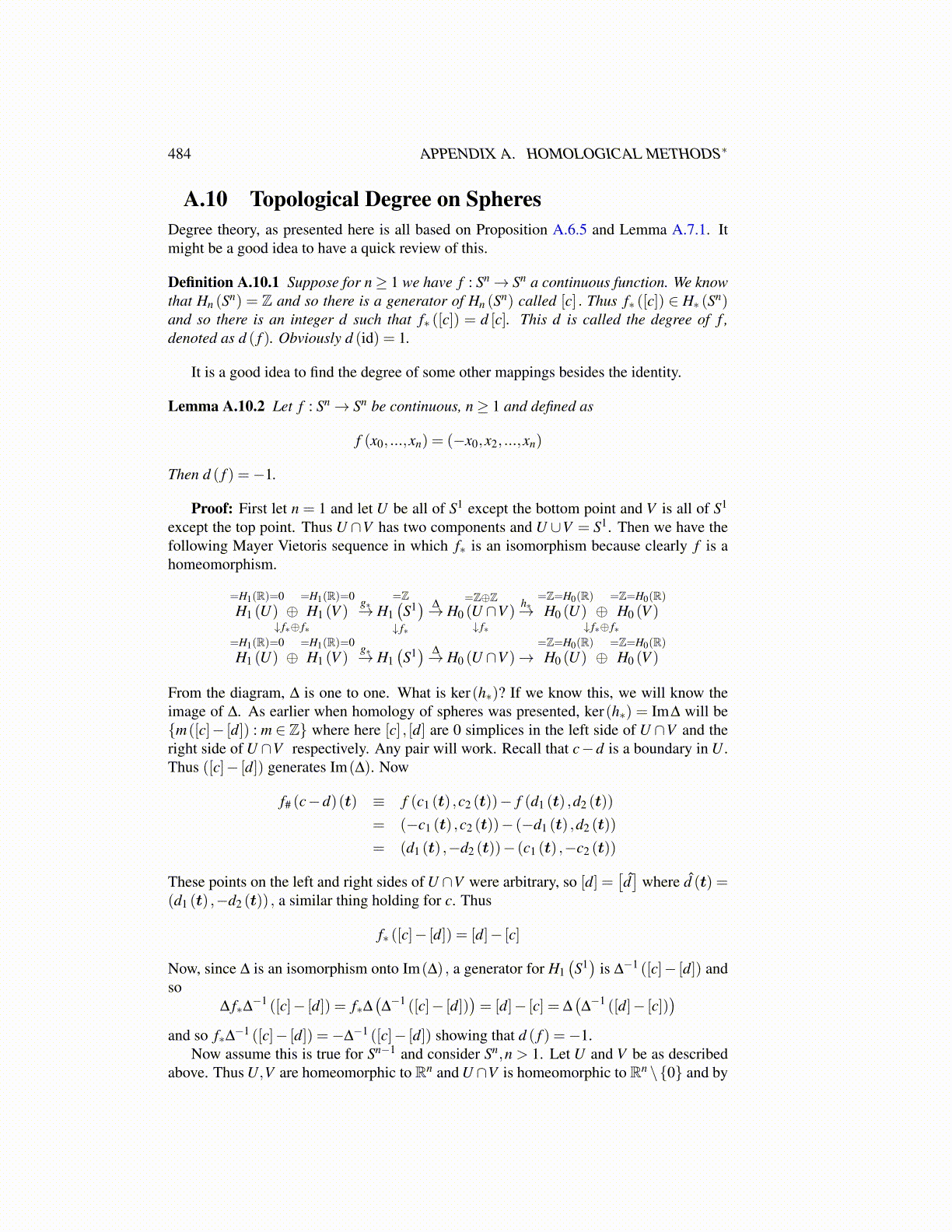
484 APPENDIX A. HOMOLOGICAL METHODS∗
A.10 Topological Degree on SpheresDegree theory, as presented here is all based on Proposition A.6.5 and Lemma A.7.1. Itmight be a good idea to have a quick review of this.
Definition A.10.1 Suppose for n≥ 1 we have f : Sn→ Sn a continuous function. We knowthat Hn (Sn) = Z and so there is a generator of Hn (Sn) called [c] . Thus f∗ ([c]) ∈ H∗ (Sn)and so there is an integer d such that f∗ ([c]) = d [c]. This d is called the degree of f ,denoted as d ( f ). Obviously d (id) = 1.
It is a good idea to find the degree of some other mappings besides the identity.
Lemma A.10.2 Let f : Sn→ Sn be continuous, n≥ 1 and defined as
f (x0, ...,xn) = (−x0,x2, ...,xn)
Then d ( f ) =−1.
Proof: First let n = 1 and let U be all of S1 except the bottom point and V is all of S1
except the top point. Thus U ∩V has two components and U ∪V = S1. Then we have thefollowing Mayer Vietoris sequence in which f∗ is an isomorphism because clearly f is ahomeomorphism.
=H1(R)=0H1 (U) ⊕
=H1(R)=0H1 (V )
↓ f∗⊕ f∗
g∗→=Z
H1(S1)
↓ f∗
∆→=Z⊕Z
H0 (U ∩V )↓ f∗
h∗→=Z=H0(R)H0 (U) ⊕
=Z=H0(R)H0 (V )
↓ f∗⊕ f∗=H1(R)=0H1 (U) ⊕
=H1(R)=0H1 (V )
g∗→ H1(S1) ∆→ H0 (U ∩V )→
=Z=H0(R)H0 (U) ⊕
=Z=H0(R)H0 (V )
From the diagram, ∆ is one to one. What is ker(h∗)? If we know this, we will know theimage of ∆. As earlier when homology of spheres was presented, ker(h∗) = Im∆ will be{m([c]− [d]) : m ∈ Z} where here [c] , [d] are 0 simplices in the left side of U ∩V and theright side of U ∩V respectively. Any pair will work. Recall that c−d is a boundary in U .Thus ([c]− [d]) generates Im(∆). Now
f# (c−d)(t) ≡ f (c1 (t) ,c2 (t))− f (d1 (t) ,d2 (t))
= (−c1 (t) ,c2 (t))− (−d1 (t) ,d2 (t))
= (d1 (t) ,−d2 (t))− (c1 (t) ,−c2 (t))
These points on the left and right sides of U ∩V were arbitrary, so [d] =[d̂]
where d̂ (t) =(d1 (t) ,−d2 (t)) , a similar thing holding for c. Thus
f∗ ([c]− [d]) = [d]− [c]
Now, since ∆ is an isomorphism onto Im(∆) , a generator for H1(S1)
is ∆−1 ([c]− [d]) andso
∆ f∗∆−1 ([c]− [d]) = f∗∆(∆−1 ([c]− [d])
)= [d]− [c] = ∆
(∆−1 ([d]− [c])
)and so f∗∆−1 ([c]− [d]) =−∆−1 ([c]− [d]) showing that d ( f ) =−1.
Now assume this is true for Sn−1 and consider Sn,n > 1. Let U and V be as describedabove. Thus U,V are homeomorphic to Rn and U ∩V is homeomorphic to Rn \{0} and by